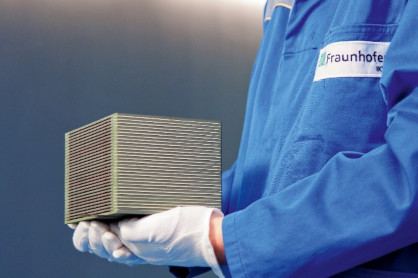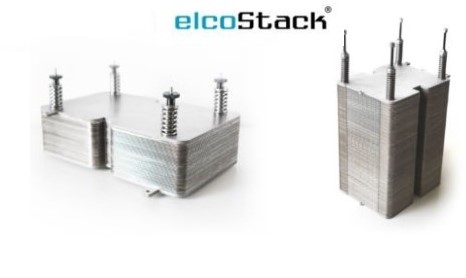Solid Oxide Electrolysis Cells Electrolyser
Solid oxide fuel cells (SOFC) have been extensively developed as a low-carbon, efficient electrical power production technology but emerge now also in the use as solid oxide electrolysis cells (SOEC). Under applied electrical potential a solid oxide electrolyser cell (SOEC) splits water (H2O) into hydrogen (H2) by transferring oxygen ions (O2-) through a solid ionic conductive membrane that after are recombining with electrons to form oxygen molecules (O2). Based on the electrochemical reaction it is possible to split carbon dioxide (CO2) to carbon monoxide (CO) or mixtures of water and carbon dioxide (H2O+CO2) to generate specific synthesis gases (mainly CO and H2) for subsequent processes. Because of the integration of excess heat to the SOEC process the efficiency of SOEC systems can be higher than other electrolysis technologies.
Solid oxide electrolyser cells operate at temperatures between 700 and 1000 °C which enable nonprecious metals as catalysts. The general function of the solid electrolyser cell in the ARENHA project is to generate pure H2 from steam which will be afterwards used in synthesis to generate ammonia.
For reasonable hydrogen production single cells have to be stacked. To ensure the electric contacting and gas flow of each cell, interconnects and contact elements are used.
Fraunhofer IKTS has been developing electrolyte supported cells and stacks for over 15 years and delivered stacks (Figure 1, left) and integrated stack modules to several applications.
Elcogen on the other hand is specialised in electrode supported cell and stack design for SOC, that allows to operate at lower temperatures. Starting from 2001, several generations of cells and stacks have been developed (Figure 1, right) to achieve very high efficiency at competitive cost, with multilayer ceramic cell as a core of the technology.


Picture of finalized Fhg-IKTS MK352 30-cell SOC stack (left) and two commercially available stack configurations from Elcogen: 39- and 119-cell stacks (right)
